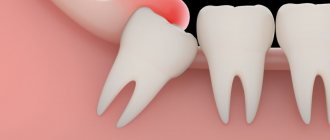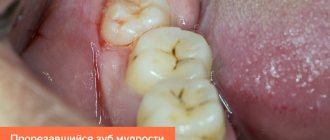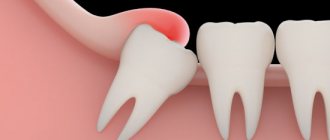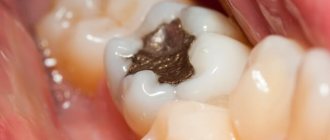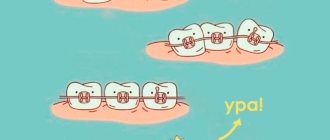01.12.2019
My child’s teeth have started to grow crooked, what should I do? How to solve the problem with milk and permanent curved row. Modern corrective orthodontic systems.
If a child’s tooth grows crookedly, then this is not only a cosmetic problem. A malocclusion can affect the health of the oral cavity and the digestive system. Bite correction must begin at an early age. At the same time, baby and permanent teeth need to be treated for curvature.
A child’s first teeth – and already crooked? Why
When a baby’s first teeth are crooked, parents don’t know what to do, whether it’s dangerous or not. Only a pediatric dentist can answer this question. After the examination, he will advise what measures need to be taken. In any case, you should not panic; it is recommended to pay attention to the following factors:
- if there are even spaces between the teeth, then it is possible to naturally correct the position of the growing units
- unequal gaps indicate shifts in tooth spacing and can lead to deformation of the permanent row
- Do not hope that after crooked baby teeth fall out, the permanent ones will be straight, this may not happen
The reasons for the formation of curvature of the first teeth are the lack of solid food, training of the chewing reflex, diseases of the nasopharynx, heredity, and incorrect anatomy of the frenulum.
Attention! Feeding from a bottle with a soft nipple often causes curvature of the milk line, which then affects the permanent one.
Features of diagnosing dental anomalies
The diagnosis is made even if the tooth is rotated only a few degrees around its axis. Cases of turning at an angle of up to 45° are classified as minor, and all others are classified as significant. The maximum rotation angle of the dental crown is 180°.
To diagnose and develop a pathology correction program, the patient may be prescribed:
- X-ray of the problem area;
- orthopantomogram, which allows assessing the quality of tissue;
- anthropometric analysis, during which, using specially prepared models of the patient’s jaws, the parameters of the components of his dental system are determined and their relationship is analyzed.
Diagnostics makes it possible to identify the cause of tortocclusion and develop a treatment program that corresponds to the degree of its severity and the condition of the dental tissues. When the teeth are rotated by 10–20°, they resort to straightening the teeth with braces, a trainer or a plate. When the angle is 20–40°, special orthodontic devices based on a spring arch and elastic rings are used. In even more complex cases, orthodontic treatment is combined with surgical treatment.
Are your new teeth growing crooked? A few words about braces
If, after falling out, new teeth grow crookedly, then the cause may be late loss of milk teeth. In addition, the uneven eruption of the molar units plays a role, and also that the jaw in its formation lags behind the eruption of large elements. In this case, new teeth can grow not only crooked, but also in two rows. If the curvature is temporary, then the appearance of a double row requires the intervention of an orthodontist. Currently, there is an effective system for correcting malocclusion and curvature - braces. They are attached to the enamel coating and work according to a tension system of various structural elements. This alignment of the teeth is a long process and inconvenient for the baby, since braces cannot be removed during the treatment period. There are two types of braces - those attached to the outside of the row and to the inside. The first are called vestibular, the second - lingual. But the latter complicate the chewing process, so they are rarely used for children.
Braces
Wearing these devices is often recommended for children whose baby teeth are completely missing and their molars are growing incorrectly. Not all teenagers feel the desire to wear such structures in their mouths. The task of parents and doctors is to explain to the child in an accessible form that they will help him find a beautiful smile. In addition, there are attractive braces - sapphire, ceramic, multi-colored.
It makes the most sense to install such structures during the holidays. This will allow the child to better survive the adaptation period. At first, braces may chafe, interfere with normal speech, and cause discomfort. In the future, you should visit a doctor once every month and a half to change the location of the structure.
Is it possible to completely correct crooked teeth?
Having discovered a problem, parents wonder whether it is possible to correct crooked teeth and how to do this so that the baby does not experience discomfort. Alignment is easier for children than for adults.
- Gum tissues are pliable and perfectly susceptible to orthopedic influences.
- Dental units are plastic, so they easily fall into place
- Children's bites can be corrected without the use of radical methods.
Keep in mind! Complete correction of the dentition in childhood is possible; this must be done before the age of 8 years. Timely correction will help avoid orthodontic problems in the future.
Why does thorotoanomaly occur?
Most often, the tooth is forced to take a pathological position due to lack of space in the jawbone due to macrodentia (large teeth in relation to the bone) or an excessively narrow jaw. In this case, it tends to turn around so as to take up as little space as possible, and the minimum will be achieved when turning at an angle of 45°. But pathology arises not only due to the primary lack of free space.
- The crown can rotate in the socket due to constant pressure exerted on it from the side or below, either by a supernumerary tooth, or by complete “neighbors” that erupt not entirely physiologically - for example, with a delay.
- Quite often, erupting permanent teeth unfold due to the persistence of the milk teeth that precede them. If during the period when baby teeth fall out, the “old” one is in no hurry to fall out, then the “new” molar will have to bypass the obstacle, deviating to the side or turning around the vertical. Pathology can be avoided by timely removal of worn-out milk teeth.
- Sometimes the cause of non-physiological tooth eruption is a dental follicle that is incorrectly formed during pregnancy or in early infancy.
- Often a permanent tooth rotates as a result of a mechanical injury received by a child at the stage of changing the primary bite to a permanent one.
What to do if your child’s teeth begin to grow crookedly
When a child has crooked teeth, parents will learn from a doctor’s consultation what to do and how not to be late with straightening. The step-by-step actions look like this:
- monitor your baby’s oral cavity and pay attention to how the baby teeth change position
- pays attention to nutrition, introduce calcium, vitamins, microelements into the diet
- start feeding solid foods on time from 8 months of age
- treat chronic diseases of the nasopharynx, eliminate problems when the baby breathes through the mouth
- make efforts to eliminate the habit of sucking a pacifier, finger, constantly sleeping with a bottle
By eliminating the causes and being vigilant and not postponing a visit to the pediatric dentist, you can solve the problem in a timely manner.
Causes of malocclusion in children
The bite is formed in the womb and is often determined by heredity
or
the mother's nutrition
during pregnancy. The active occurrence of deviations occurs immediately after birth. Their causes, in addition to genetics, include eating habits, sleeping positions, habits and illnesses:
- Artificial feeding.
Children are born with different jaw sizes: the lower one is slightly shortened. Up to a year, the jaws are leveled due to the active work of the muscles and jaws during breastfeeding. When sucking a bottle, the lower jaw almost does not strain and does not develop, lagging behind the upper jaw.
- Breastfeeding after 1.5 years.
After this age, solid foods must be introduced into the child's diet. Due to active work during chewing, muscles, jaws and teeth develop and grow correctly. - Frequent sucking of pacifiers, fingers, pencils.
The constant presence of objects in the mouth prevents teeth from growing correctly and causes an open bite - a complete lack of contact in part of the dentition.
Formation of malocclusion
- Incorrect sleeping and feeding positions.
Throwing back the head, lowering the chin to the chest, hand under the cheek during sleep; - Diseases of the otolaryngological organs.
Natural human breathing occurs through the nose. If, due to a chronic runny nose, deviated septum, or adenoids, the child breathes mainly through the mouth, then the bite is formed incorrectly.
Fighting crooked baby teeth in a child
A child's crooked baby teeth can straighten naturally. In infants, bone jaw structures are formed, gum tissue grows, and teeth erupt. These processes are accompanied by some deformations, which dentists consider to be transient. That is, as all the units in the row appear, each of them finds its place, grinds in and is leveled. But if uneven gaps appear between the teeth, noticeable even to you, then urgent measures need to be taken. This sign is evidence of asymmetry in the development of the jaws. The consequences of curvature of the mammary row are unpleasant for the baby:
- a crooked tooth causes injury to the oral cavity, causing stomatitis
- poor chewing of food, affecting the functioning of the gastrointestinal tract
- there is pain in the jaw joint
- Difficulties in brushing contribute to the formation of oral infections and caries
That is, you need to fight the problem, but to do this you need to use the methods recommended by the doctor. For example, an effective system for correcting primary teeth is the use of soft vestibular plates that guide the growth of units and eliminate the defect at a very early stage.
Signs of malocclusion in children
Noticeable external symptoms:
- Incorrectly positioned, tilted or turned teeth;
- Large gaps between teeth or crowding;
- Disproportional jaws: too protruding in relation to each other or underdeveloped.
Indirect signals:
- The child bites his cheeks or tongue;
- Complains of pain in the jaw and facial muscles;
- Breathes mainly through the mouth;
- He has difficulty swallowing or chewing food;
- New teeth erupt with a delay.
Children's open bite
If you suspect a deviation from the norm, you should visit an orthodontist without self-treatment. Even in the absence of symptoms of malocclusion, a preventative consultation with a doctor is recommended after 2-3 years in order to identify problems as early as possible.
How to correct crooked permanent teeth in a child
When children have crooked permanent teeth, the problem becomes much more complicated. The new units that have grown to replace dairy ones are larger. They need more space, the jaw develops more slowly, so the tooth becomes crooked and remains that way in the formed row. Permanent units have more powerful roots and are difficult to force to change position.
Correcting curvature with braces should begin in middle school. You will have to wear them for about 20 months. By adolescence, the dentition will already become normal, the child will not be embarrassed. It is advisable to use transparent lingual braces. They are attached to the inside and are invisible to other people.
Pain and inflammation of the gums above the wisdom tooth -
In this section we will tell you what to do when your wisdom tooth comes out and your gums hurt. As we said above, pain can be associated either with inflammation of the gums above the erupting tooth, or with displacement of the teeth. In the latter case, this is similar to the movement of teeth through the use of braces (only in this case, the movement of teeth will be provoked not by a metal arch, but by an erupting wisdom tooth). The first thing you should do is look into your mouth and assess the situation.
Inflammation of the gums above the wisdom tooth occurs when one part of the crown has already erupted, and the second is still covered with mucous membrane (Fig. 2). That part of the gum mucosa that hangs over the crown of the eighth tooth is what dentists call the “hood.” Food debris and microbial plaque usually accumulate in this place, which leads to inflammation of the mucous membrane and pain.
In addition to pain, the presence of inflammation of the gums above the wisdom tooth is usually indicated by: 1) redness and swelling of the gums, 2) suppuration from under the hood, but sometimes pus can only be released when pressing on it, 3) bad breath, 4) less often may be fever, painful swallowing or difficulty opening the mouth, as well as swelling of the cheek. The presence of symptoms from the last point indicates an unfavorable course of inflammation. Dentists call inflammation of the hood over a wisdom tooth “pericoronitis.”
Eruption of wisdom teeth and “pericoronitis” –
A wisdom tooth is coming out, your gums hurt: what to do if the hood is small and covers only a small part of the crown of the wisdom tooth, and there is no active inflammation (suppuration, painful swallowing, etc.) - antiseptic rinses with Chlorhexidine solution and applications of the anti-inflammatory gel Cholisal can help. In case of severe pain, it is advisable to simultaneously take analgesics from the NSAID group, for example, ibuprofen. These drugs have not only analgesic, but also a pronounced anti-inflammatory effect.
But in all other cases, a minor surgical intervention will be necessary - excision of the hood. The operation is low-traumatic and takes only a few minutes. Its goal is to remove the area of the gum mucosa that hangs over the crown of the tooth. In some cases (when the doctor sees that in any case there is not enough space for the tooth to erupt, which means excision of the hood will only give a temporary effect), the dental surgeon decides to remove the wisdom tooth.
Pericoronitis and laser excision of the hood: video 1-2
Local anti-inflammatory therapy –
- antiseptic rinses with 0.05% Chlorhexidine solution,
- applications with Cholisal-gel.
Treatment of inflamed gums is carried out 2-3 times a day - in the morning after breakfast and brushing your teeth, in the evening (before bed) after brushing your teeth, and also in the middle of the day. Each time, you first need to rinse your mouth with Chlorhexidine for 1 minute - then dry the gums with a dry gauze swab and apply the gel to the surface of the hood using your finger. Afterwards, you should not rinse your mouth or eat food for 2-3 hours. By the way, Cholisal gel, in addition to a pronounced anti-inflammatory effect, also has an analgesic effect.
How can you straighten your child's teeth without using braces?
Modern dentists know how to correct crooked teeth without braces. To do this, there are techniques and systems that do not need to be worn constantly.
- The use of plates that are removable devices. They guide the position of the tooth individually and the row as a whole. Made from casts
- Trainers help adjust units to the correct position. They can be removed and are made of flexible material that is not felt on the jaw
- Myotherapy is a special set of exercises for training the jaw apparatus and surrounding muscles
The doctor will decide which of these methods is suitable in your case, taking into account all the circumstances and features of the development of the defect.
Category Children Published by Mister stomatolog
Removable devices
These devices are convenient because they can be easily removed for hygiene procedures or eating. It is important for parents to ensure that the child does not do this on his own - intentionally or accidentally. If necessary, the devices allow you to expand the jaw. There are three types of removable devices:
- Records. Suitable for children from seven years to early teens. They are made of thin wire equipped with a base made of polymer material. Sometimes they can be equipped with screws and springs.
- Trainers. Designed for preschool children. Wearing such devices can be recommended not only by orthodontists, but also by speech therapists, since the devices help improve diction. Trainers help in correcting the bite when the tongue is positioned incorrectly, as well as in cases of disorders associated with mouth breathing.
- Orthodontic nipples. Designed for babies.


